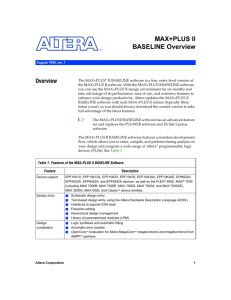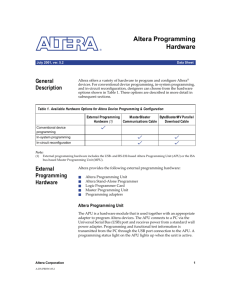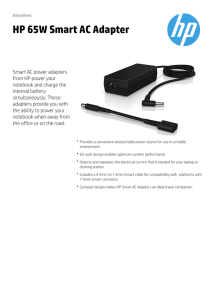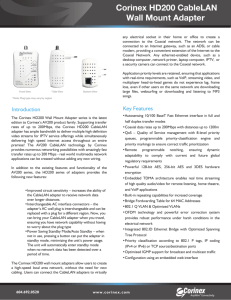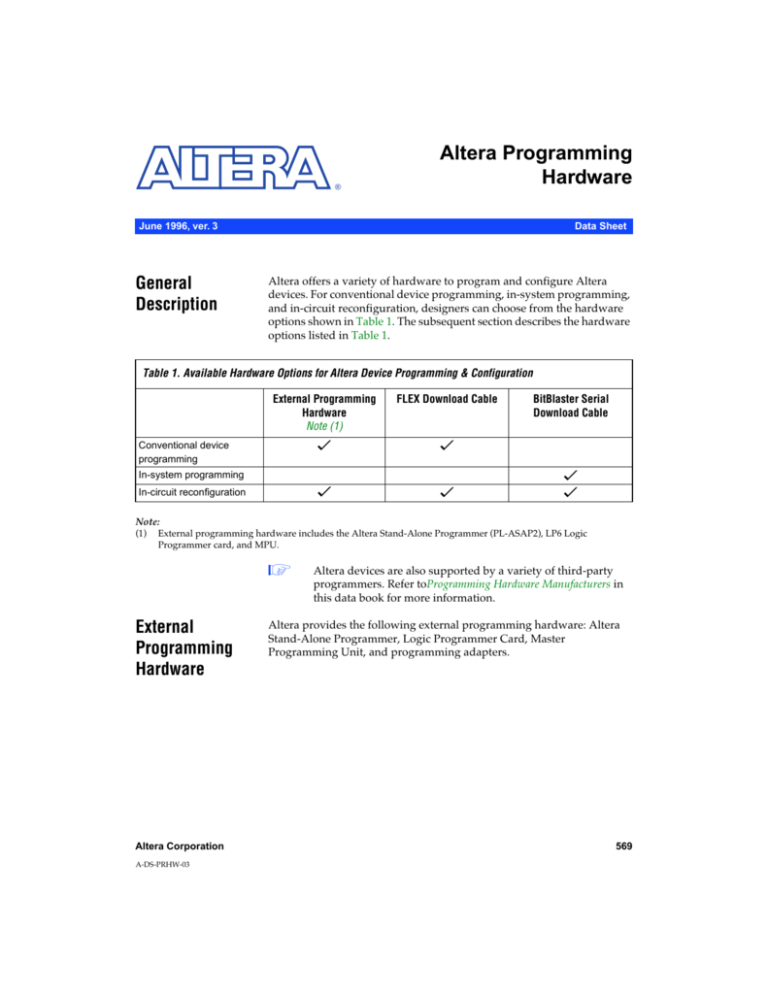
®
Altera Programming
Hardware
June 1996, ver. 3
General
Description
Data Sheet
Altera offers a variety of hardware to program and configure Altera
devices. For conventional device programming, in-system programming,
and in-circuit reconfiguration, designers can choose from the hardware
options shown in Table 1. The subsequent section describes the hardware
options listed in Table 1.
Table 1. Available Hardware Options for Altera Device Programming & Configuration
External Programming
Hardware
Note (1)
FLEX Download Cable
v
v
v
v
Conventional device
programming
BitBlaster Serial
Download Cable
v
In-system programming
In-circuit reconfiguration
v
Note:
(1)
External programming hardware includes the Altera Stand-Alone Programmer (PL-ASAP2), LP6 Logic
Programmer card, and MPU.
1
External
Programming
Hardware
Altera Corporation
A-DS-PRHW-03
Altera devices are also supported by a variety of third-party
programmers. Refer toProgramming Hardware Manufacturers in
this data book for more information.
Altera provides the following external programming hardware: Altera
Stand-Alone Programmer, Logic Programmer Card, Master
Programming Unit, and programming adapters.
569
Altera Programming Hardware Data Sheet
Altera Stand-Alone Programmer
The Altera Stand-Alone Programmer, PL-ASAP2, together with the
appropriate programming adapters, provides the hardware and software
needed for either programming EPROM-, EEPROM-, and FLASH-based
Altera devices, or configuring SRAM-based devices. PL-ASAP2 includes
an LP6 Logic Programmer card, an MPU, MAX+PLUS II Programmer
software (which requires Microsoft Windows or Windows NT), and
complete documentation. The MAX+PLUS II Programmer supports
device configuration for FLEX 10K and FLEX 8000 devices, and device
programming for MAX 9000, MAX 7000, FLASHlogic, MAX 5000, and
Classic devices.
Ordering Code:
PL-ASAP2
Logic Programmer Card
The LP6 Logic Programmer card generates programming waveforms and
voltages for the MPU. The software-controlled card can be installed into
any full-length computer expansion slot in an IBM PC-AT or compatible
computer. The LP6 card is available as part of PL-ASAP2 or individually.
Ordering Code:
PLP6
Master Programming Unit
The Master Programming Unit (MPU) is a hardware module that is used
together with an appropriate adapter to program Altera devices. The
MPU connects to a Logic Programmer card via a 25-pin ribbon cable. The
MPU receives power from the Logic Programmer card installed in an IBM
PC-AT or compatible computer and does not require an external power
supply. Programming and functional test information is transmitted from
the Logic Programmer card through the ribbon cable to the MPU. A
programming status light on the MPU lights up when the unit is active.
When used with the appropriate adapter, the MPU automatically tests for
continuity between the device leads and the programming socket before
programming. It can also apply test vectors to functionally test and verify
programmed Altera devices. Test vectors can be created in waveform or
text format in the MAX+PLUS II Waveform Editor or Text Editor and
applied to the device; results can be viewed in waveform or text format.
The MPU is available as part of the PL-ASAP2 or individually.
Ordering Code:
570
PL-MPU
Altera Corporation
Altera Programming Hardware Data Sheet
Programming Adapters
Altera provides three types of programming adapters for Altera devices:
PLM-prefix adapters, PLE-prefix adapters, and the PLAD3-12
compatibility adapter. Each adapter contains one of the following sockets:
a zero-insertion-force dual in-line package (DIP), J-lead (PLCC/JLCC),
pin-grid array (PGA), small-outline integrated circuit (SOIC), or quad flat
pack (QFP). The adapters for QFP devices with 100 or more pins support
Altera’s QFP carrier technology. Table 2 on page 572 lists the adapters
required for each Altera device and package option.
f
See the QFP Carrier & Development Socket Data Sheet in this data book for
more information.
PLM-Prefix Adapters
The PLM-prefix adapters plug directly into the MPU. Each adapter
provides programming support for a specific device package.
Additionally, PLM-prefix (except the PLMJ1213 and PLMT1064) support
functional testing of programmed Altera devices. The PLMJ1213 and
PLMT1064 adapters can either program the Configuration EPROMs used
to configure FLEX 10K and FLEX 8000 devices or download configuration
data directly to the FLEX 10K or FLEX 8000 device via the FLEX
Download Cable.
PLE-Prefix Adapters
The PLE-prefix adapters plug into the PLAD3-12 compatibility adapter,
which in turn plugs into the MPU. Each of these adapters provides
programming support for a specific Classic device.
PLAD3-12 Compatibility Adapter
The PLAD3-12 compatibility adapter plugs directly into the MPU. This
adapter allows PLE-prefix adapters to be used with the MPU.
Altera Corporation
571
Altera Programming Hardware Data Sheet
Table 2. Programming Adapters (Part 1 of 2)
Device
572
Package
Adapter
BitBlaster
Support
v
FLEX 10K
All packages
Note (1)
FLEX 8000
All packages
Note (1)
v
EPC1, EPC1V
Note (2)
DIP
J-Lead
PLMJ1213
PLMJ1213
_
EPC1064
DIP
J-lead
TQFP
PLMJ1213
PLMJ1213
PLMT1064
–
EPC1213
DIP
J-lead
PLMJ1213
PLMJ1213
–
EPM9320
J-lead (84-pin)
RQFP (208-pin)
PGA (280-pin)
PLMJ9320-84
PLMR9000-208
PLMG9000-280
v
EPM9400
J-lead (84-pin)
RQFP (208-pin)
RQFP (240-pin)
PLMJ9400-84
PLMR9000-208
PLMR9000-240
v
EPM9480
RQFP (208-pin)
RQFP (240-pin)
PLMR9000-208
PLMR9000-240
v
EPM9560
CQFP (208-pin)
RQFP (208-pin)
RQFP (240-pin)
PGA (280-pin)
RQFP (304-pin)
PLMR9000-208
PLMR9000-208
PLMR9000-240
PLMG9000-280
PLMR9000-304
v
EPM7032
EPM7032V
EPM7032S
J-lead
PQFP
TQFP
PLMJ7000-44
PLMQ7000-44
PLMT7000-44
v3
EPM7064
EPM7064S
J-lead (44-pin)
TQFP (44-pin)
J-lead (68-pin)
J-lead (84-pin)
PQFP (100-pin)
PLMJ7000-44
PLMT7000-44
PLMJ7000-68
PLMJ7000-84
PLMQ7000-100
v3
EPM7096
EPM7096S
J-lead (68-pin)
J-lead (84-pin)
PQFP (100-pin)
PLMJ7000-68
PLMJ7000-84
PLMQ7000-100
v3
EPM7128E
EPM7128S
J-lead (84-pin)
PQFP (100-pin)
PQFP (160-pin)
PLMJ7000-84
PLMQ7000-100
PLMQ7128/7160-160
v(3)
EPM7160E
EPM7160S
J-lead (84-pin)
PQFP (100-pin)
PQFP (160-pin)
PLMJ7000-84
PLMQ7000-100
PLMQ7128/7160-160
v(3)
Altera Corporation
Altera Programming Hardware Data Sheet
Table 2. Programming Adapters (Part 2 of 2)
Device
Package
Adapter
BitBlaster
Support
EPM7192E
EPM7192S
PGA (160-pin)
PQFP (160-pin)
PLMG7192-160
PLMQ7192/7256-160
v(3)
EPM7256E
EPM7256S
PGA (192-pin)
PQFP (160-pin)
RQFP (208-pin)
PLMG7256-192
PLMQ7192/7256-160
PLMR7256-208
v(3)
EPX880
J-lead (84-pin)
PQFP (132-pin)
Note (4)
v
EPX8160
PQFP (208-pin)
PLMQ8160-208
v
EPM5032
DIP
J-lead
SOIC
PLMD5032A
PLMJ5032A
PLMS5032A
–
EPM5064
J-lead
PLMJ5064A
–
EPM5128
J-lead
PGA
PLMJ5128A
PLMG5128A
–
EPM5130
J-lead
PGA
PQFP
PLMJ5130A
PLMG5130A
PLMQ5130A
–
EPM5192
J-lead
PGA
PLMJ5192A
PLMG5192A
–
EP6xx
DIP
J-lead
SOIC
PLED610
PLEJ610
PLES610
–
EP9xx
DIP
J-lead
PLED910
PLEJ910
–
EP18xx
J-lead
PGA
PLMJ1810
PLEG1810
–
Notes:
(1)
(2)
(3)
(4)
Configuration of FLEX 10K and FLEX 8000 devices is supported by Configuration
EPROMs (EPC1064, EPC1064V, EPC1213, EPC1, and EPC1V), the FLEX Download
Cable, and the BitBlaster.
Information on EPC1V devices is preliminary.
The BitBlaster supports the in-system programmability of MAX 7000S devices.
Programming support is currently provided through third-party vendors. Contact
Altera Applications at (800) 800-EPLD for additional information.
Ordering Codes:
Altera Corporation
PLExxxx, PLMxxxx, PLAD3-12
573
Altera Programming Hardware Data Sheet
FLEX
Download
Cable
The FLEX Download Cable together with the ASAP2 and either the
PLMJ1213 or PLMT1064 adapter allows designers to download
configuration data directly to FLEX 10K or FLEX 8000 devices.
BitBlaster
Serial
Download
Cable
The BitBlaster serial download cable is a hardware interface to a standard
RS-232 port on either a PC or UNIX workstation that provides
configuration data to FLEX 10K, FLEX 8000, and FLASHlogic devices and
programming data to MAX 9000, MAX 7000S, and FLASHlogic devices.
Ordering Code:
The 25-pin female port on the BitBlaster connects to an RS-232 port with a
standard serial cable. The 10-pin female plug on the BitBlaster connects to
a device on a circuit board via a 10-pin male header. The BitBlaster
contains status lights that indicate the state of the device configuration or
programming. Refer to the BitBlaster Serial Download Cable Data Sheet in
this data book for more information
Ordering Code:
f
574
PL-FLDLC
PL-BITBLASTER
For information on the FLASHlogic Download Cable (PL-FLDLC), see the
BitBlaster Serial Download Cable Data Sheet in this data book.
Altera Corporation
Altera Programming Hardware Data Sheet
Programming
Support
Altera customers can create a device programming environment or add to
their existing device programming support with the hardware shown in
Table 3.
Table 3. Programming Hardware Requirements
If you have . . .
And you want to
program . . .
Then you need . . .
No programming hardware
EP610
EP910
EP1810 (PGA)
PL-ASAP2, PLAD3-12 adapter, appropriate
programming adapters
No programming hardware
EP1810 (J-lead)
Any MAX 5000 device
Any MAX 7000 device
Any MAX 9000 device
Any Configuration EPROM
PL-ASAP2, appropriate programming
adapters
LP6 Logic Programmer card
EP610
EP910
EP1810 (PGA)
PL-MPU, PLAD3-12 adapter, appropriate
programming adapters
LP6 Logic Programmer card
EP1810 (J-lead)
Any MAX 5000 device
Any MAX 7000 device
Any MAX 9000 device
Any Configuration EPROM
PL-MPU, appropriate programming adapters
LP6 Logic Programmer card,
EP610
PL-MPU Master Programming Unit EP910
EP1810 (PGA)
PLAD3-12 adapter, appropriate
programming adapters
LP6 Logic Programmer card,
EP1810 (J-lead)
PL-MPU Master Programming Unit Any MAX 5000 device
EPX740
EPX780 (J-lead)
Any MAX 7000 device
Any MAX 9000 device
Any Configuration EPROM
Appropriate programming adapters
Altera Corporation
575
Copyright © 1995, 1996 Altera Corporation, 2610 Orchard Parkway,
San Jose, California 95134, USA, all rights reserved.
By accessing any information on this CD-ROM, you agree to be
bound by the terms of Altera’s Legal Notice.




